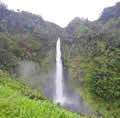2015/03 Hawaii trip - Hilo's waterfalls |
|||||
Wednesday March 4th
We had booked up for a van trip that evening from Hilo up to the observatories on Mauna Kea, partly for the novelty of walking through Hawaiian snow but also to see the stars and sunset. The regular road goes to a visitor centre above 9000 feet but from there on it’s a 4wd track and off-limits to rental cars. That morning the road had been closed because of blizzard conditions, but we hadn’t heard from the tour company yet, so we had to stay in the Hilo neighbourhood.
It was still raining heavily, jetting off the roof into the shower so the hot tap had little effect! It was a quick shower. Back in the living room our screens were being dive-bombed by a large bat, about the size of a pigeon. There seemed to be something it wanted in the room, but it would pull out of its dive inches from the screen. I assume that it was the local hoary bat, the only mammal in the islands until humans arrived.

Rain is good for waterfalls, so that’s where we headed. Hilo is built around the Wailuku River, with waterfalls where the river drops from the mountain down into Hilo Bay. We began at Pe’e Pe’e Falls; if you’re going to ask directions remember to include those glottal stops! We could see the falls in the distance but the trail was closed because of the flood danger.  Nearby is Rainbow Falls, pretty but with no rainbows on this rather soggy day. A trail led off into a forest of banyan trees, very spooky and dark.
Nearby is Rainbow Falls, pretty but with no rainbows on this rather soggy day. A trail led off into a forest of banyan trees, very spooky and dark.

 |
|---|
We had an hour or so to kill on a wet day so we dived into the Lyman museum, also nearby. We began with the geological section which included Mr. Lyman’s personal collection of specimens, some magnificent rocks.
We soon  found that there was much too much to see in the time but then we got the call that our trip was canceled so we rebooked for the Sunday night, hoping the road would reopen by then.
found that there was much too much to see in the time but then we got the call that our trip was canceled so we rebooked for the Sunday night, hoping the road would reopen by then.
The rest of the museum dealt with the arrival of people in the islands, beginning with the Hawaiians who had to build their society with no metals or clay. (The reason they stole Cook’s rowboat was for the metal nails!) Then came Europeans, Japanese, Filipinos, and Koreans.
Next door is the Mission House, the oldest wooden house on the island, and we took the tour. The house was founded in the 1820s by American missionaries, including the Lymans. They came to convert but arrived to find that the Hawaiians had already dumped their old religion; they’d noted that the  Europeans ignored all the kapu rules and Pele hadn’t smitten them, so they were already looking for an alternative. This allowed the Lymans to concentrate on education and translation of the Bible and in many ways, like in the use of electricity and printing presses,
Europeans ignored all the kapu rules and Pele hadn’t smitten them, so they were already looking for an alternative. This allowed the Lymans to concentrate on education and translation of the Bible and in many ways, like in the use of electricity and printing presses,  Hawaii was developed ahead of the American wild west. Of course, disease took a big toll of the island people too. The museum was founded by the Lymans’ great grandson. Our tour guide was a bit full of himself and inaccurate at times, but he was entertaining.
Hawaii was developed ahead of the American wild west. Of course, disease took a big toll of the island people too. The museum was founded by the Lymans’ great grandson. Our tour guide was a bit full of himself and inaccurate at times, but he was entertaining.

We drove up the Hamakua coast again, this time a little further to Akaka Falls, a picture perfect waterfall that plummets over 400 feet into a pool. The spray from Akaka (both pictures) and the nearby but mostly hidden Kahuna Falls makes for a riotous jungle of gigantic trees and leaves and vines; even a banana tree on steroids.

| Akaka Falls (3.00) |
 |
|---|
We crossed numerous steep jungly ravines on this road; this must have been extremely difficult country to cross before the roads were built. It ![]() was still raining when we got back to Keaau.
was still raining when we got back to Keaau.